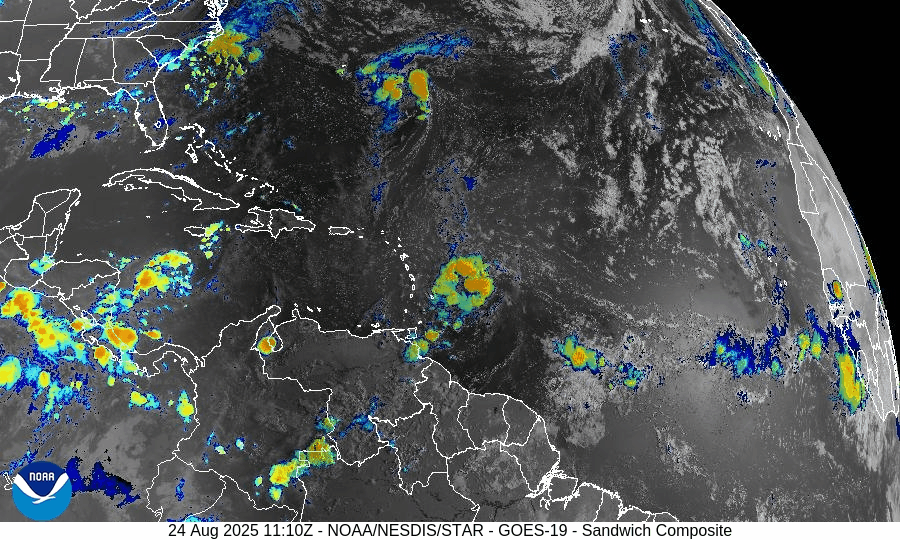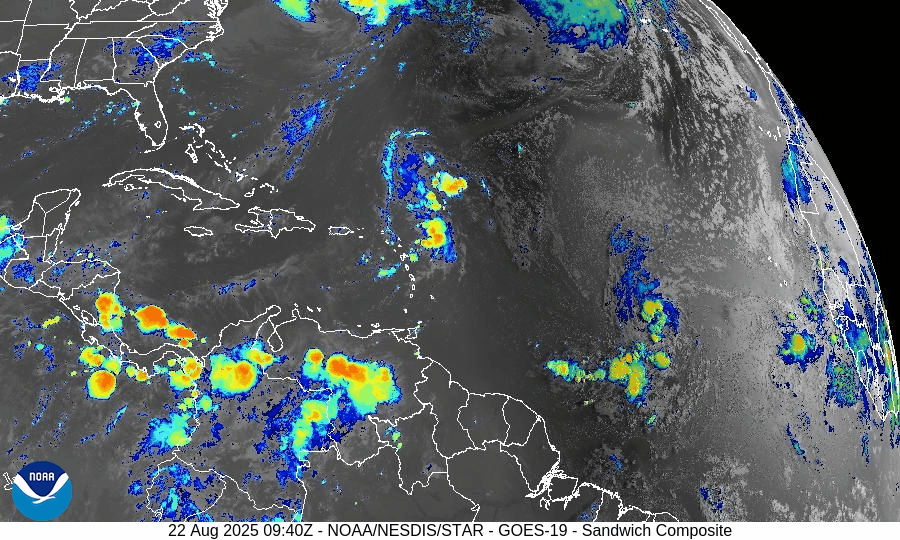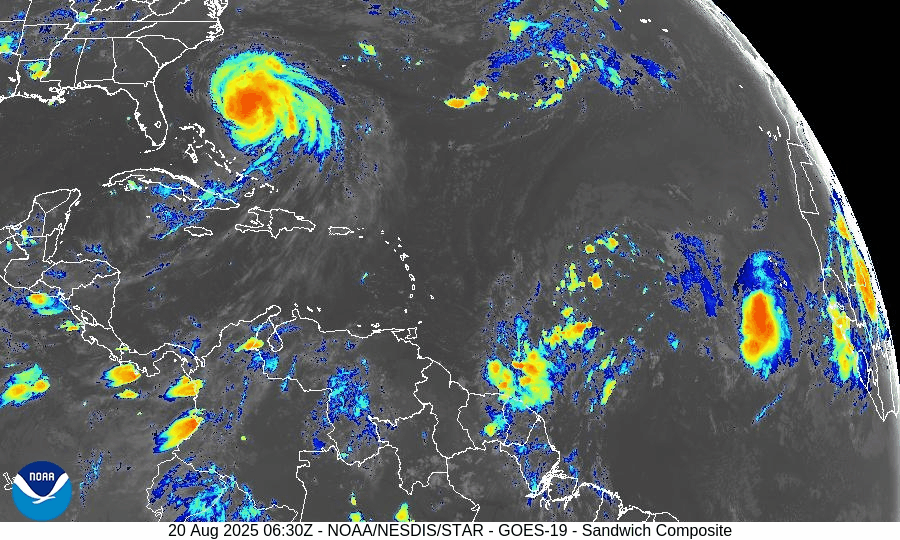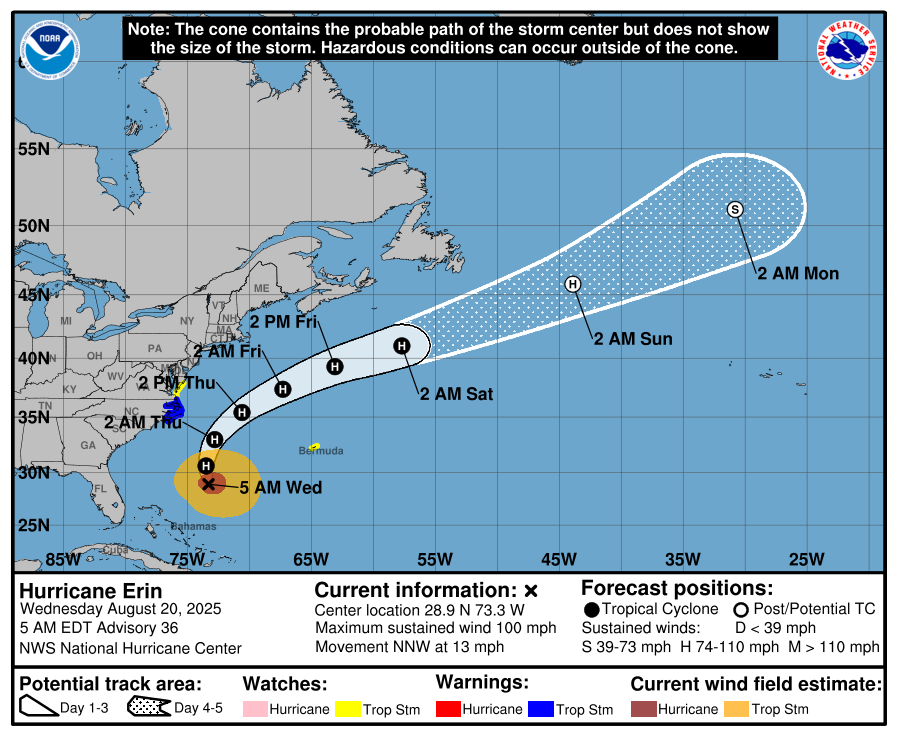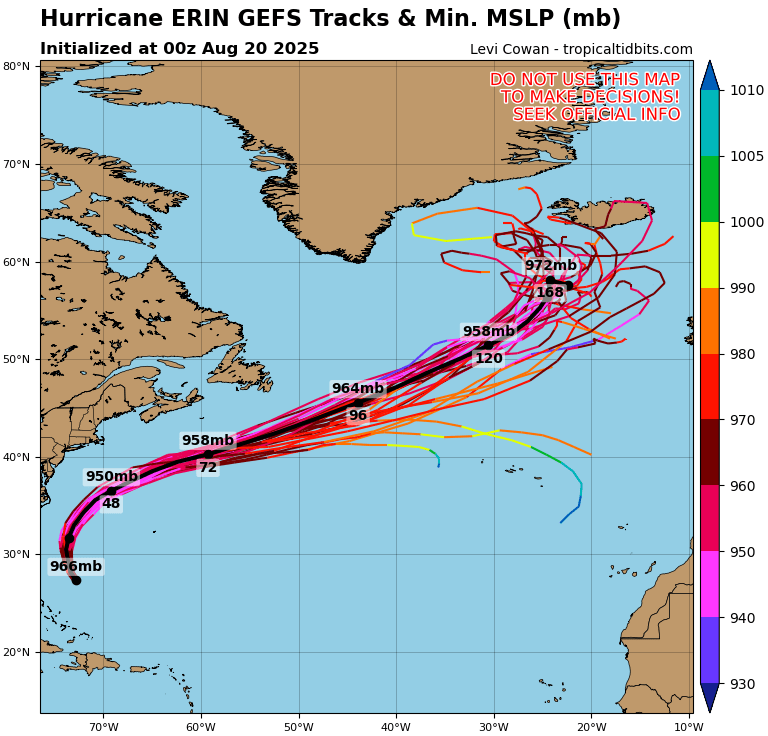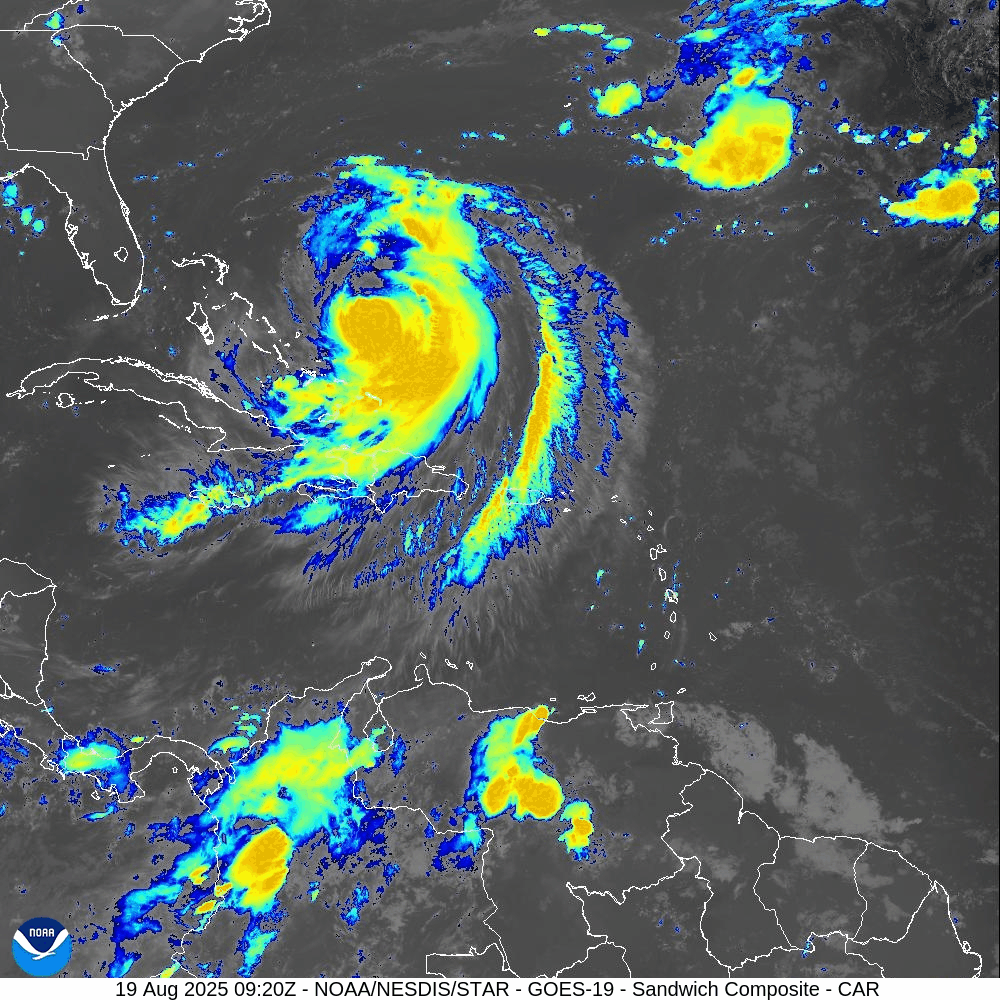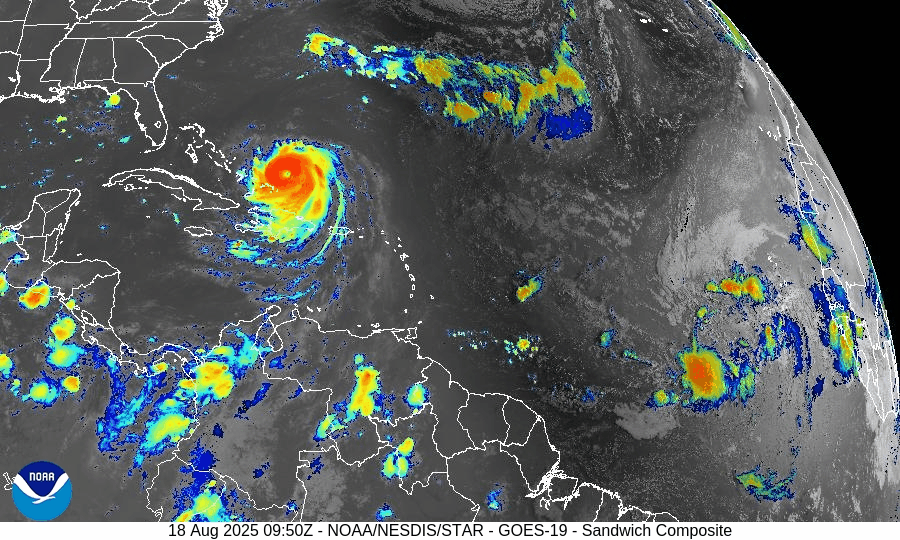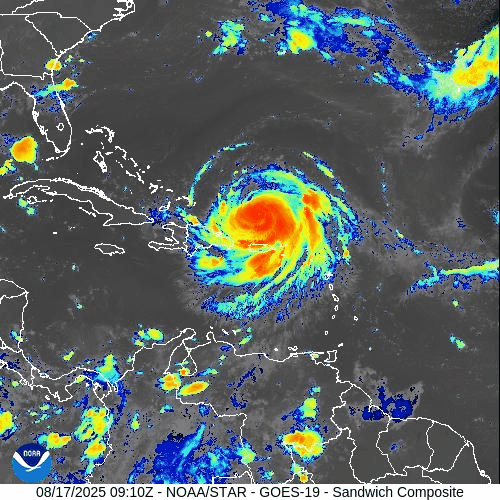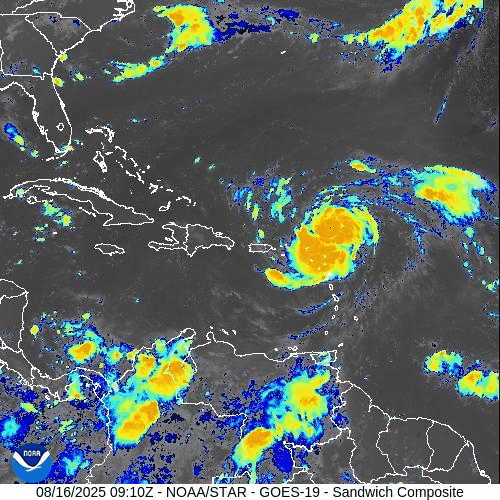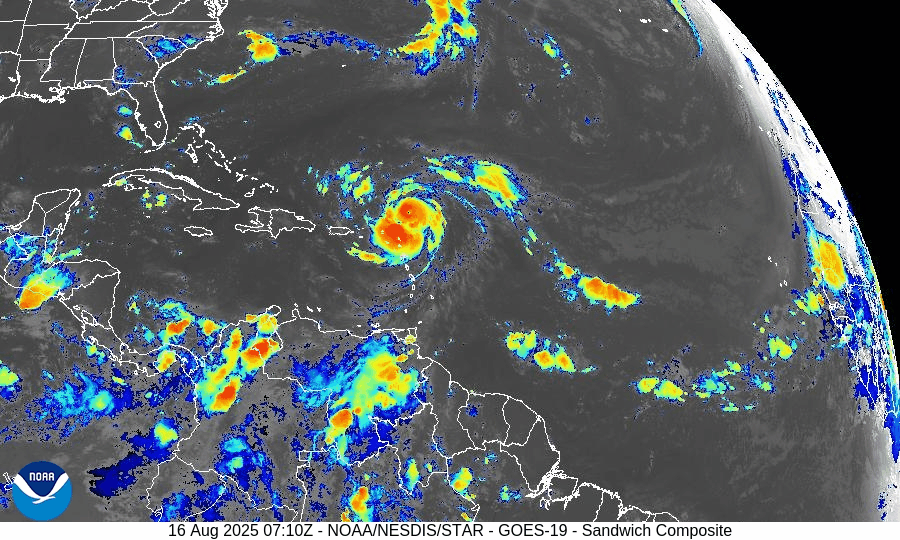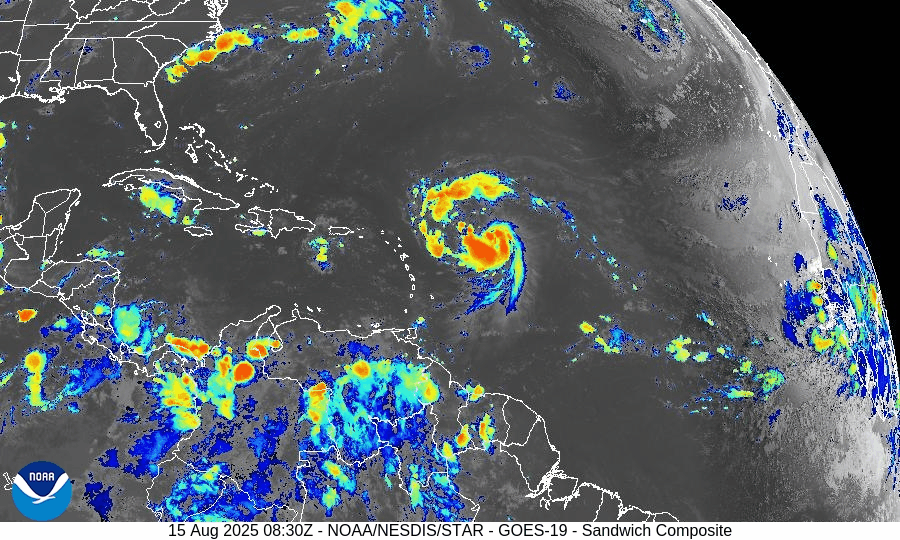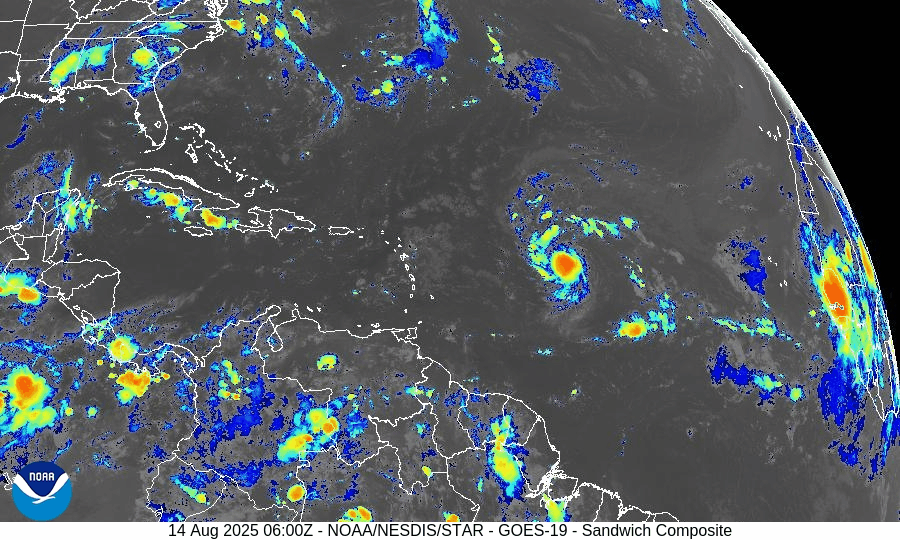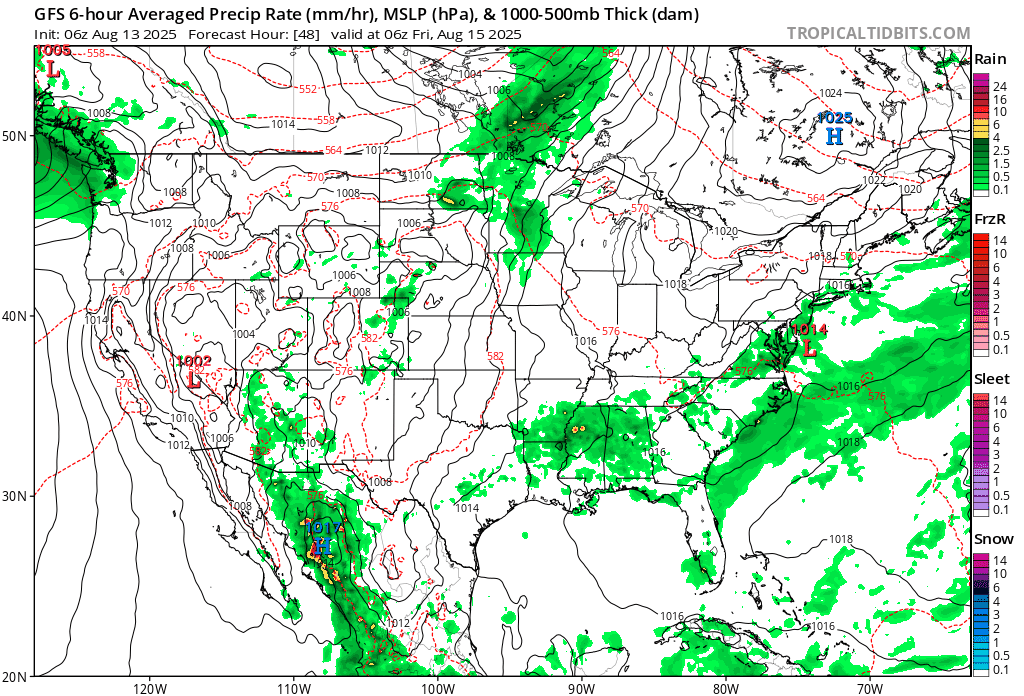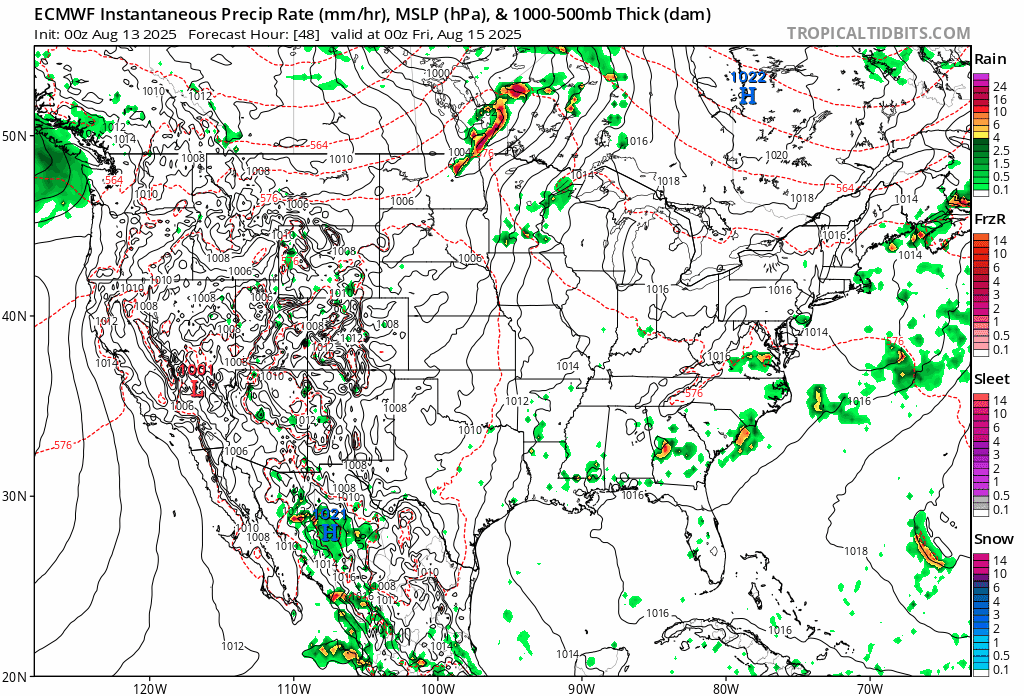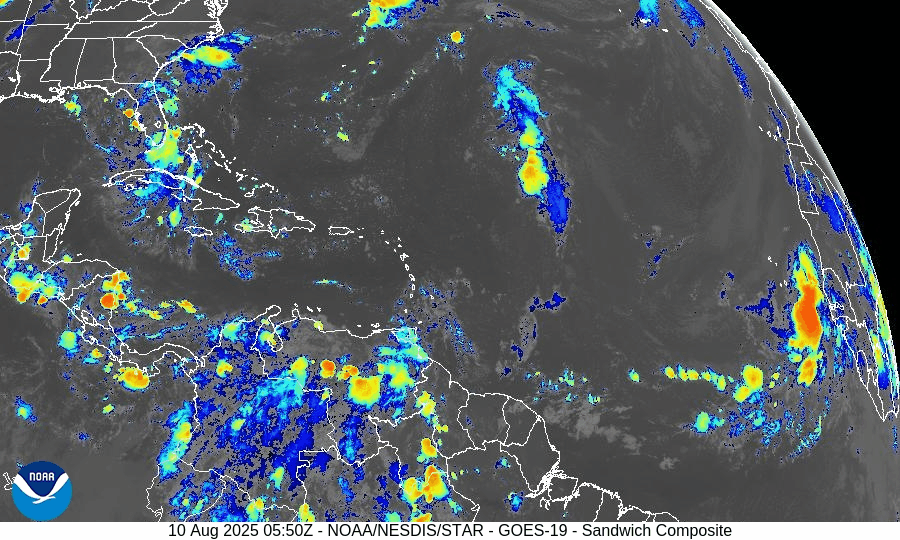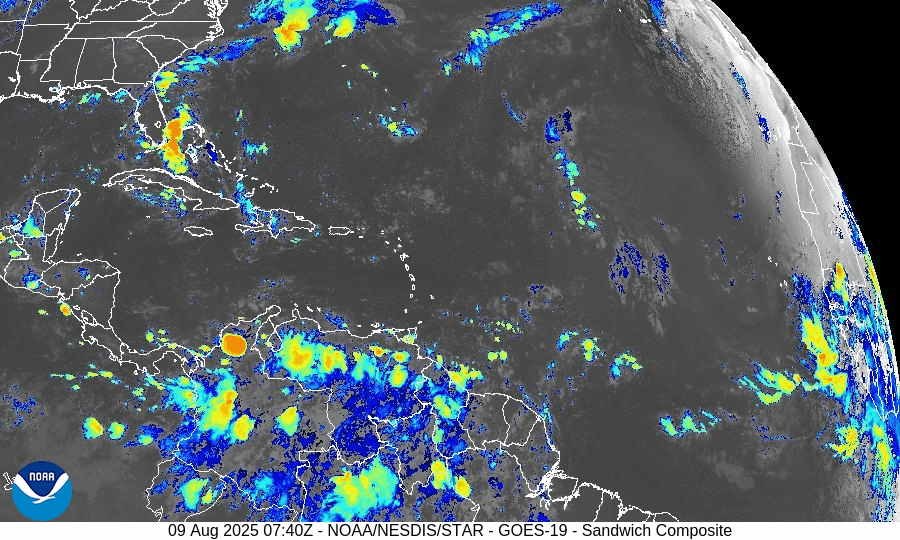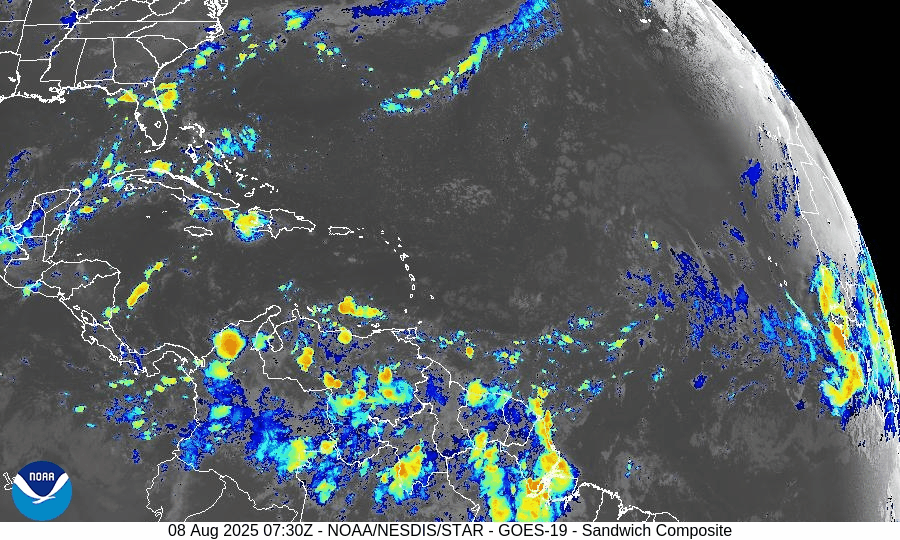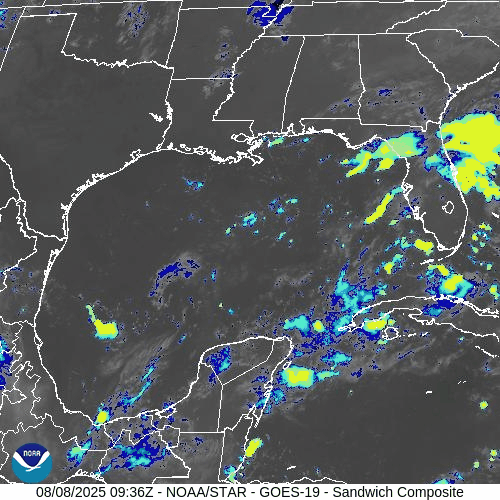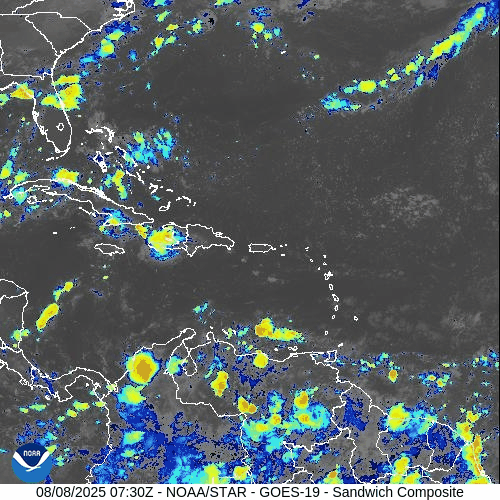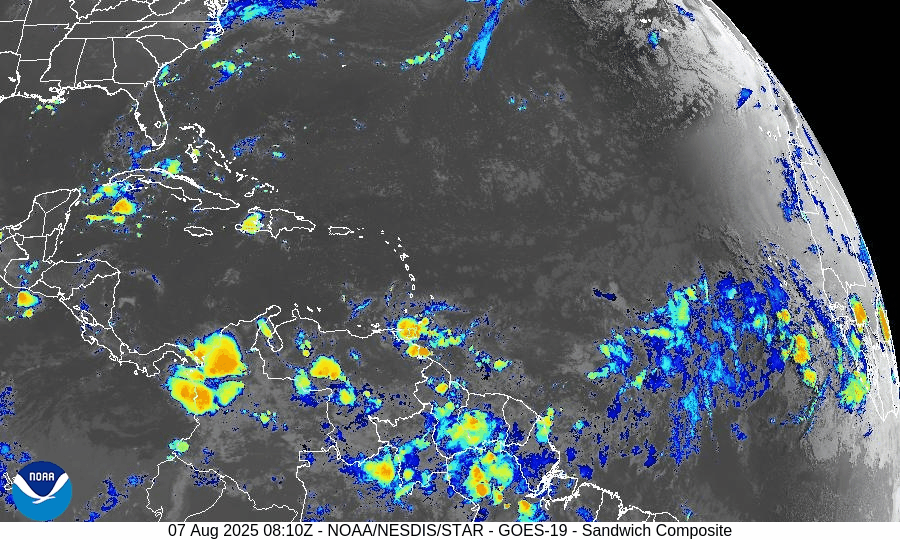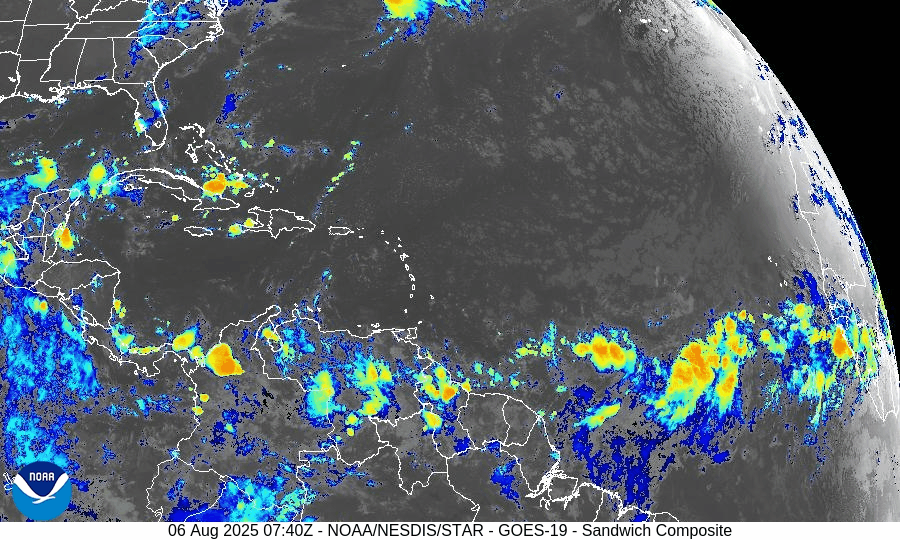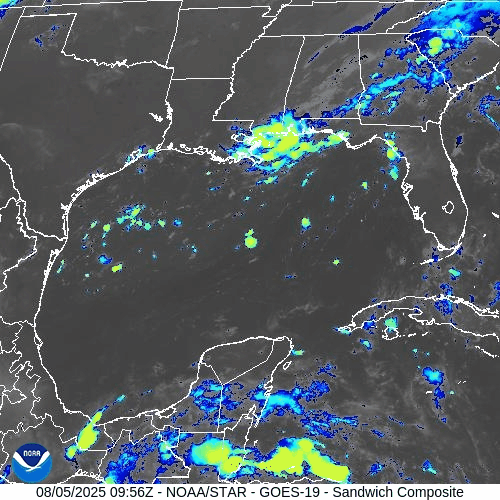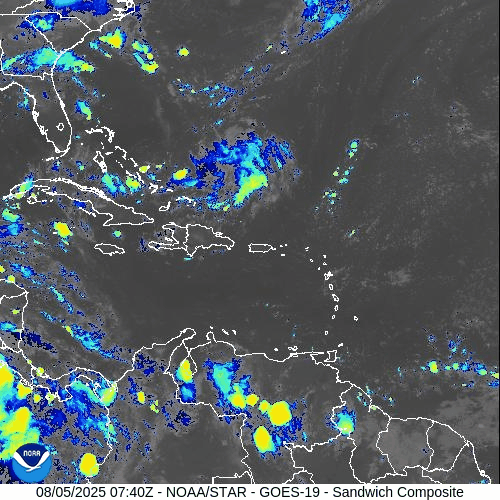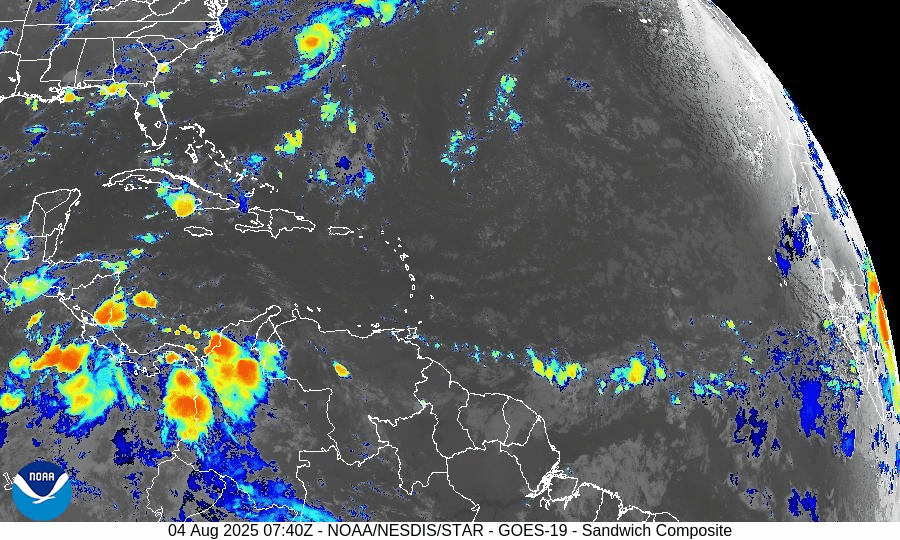Atlantic Hurricane Outlook – August 24, 2025: Tropical Storm Fernand forms southeast of Bermuda
Tropical Storm Fernand has developed in the Atlantic while Erin’s post-tropical remnants continue to generate hazardous surf and rip currents from the Carolinas to New England. Florida and the Gulf of Mexico remain calm, with only daily sea-breeze thunderstorms expected.
TLDR Version: Click Here
Tropical Storm Fernand forms southeast of Bermuda; environmental conditions shaping its strength and lifespan
Atlantic Basin Overview
Tropical Storm Fernand
A new system, Tropical Storm Fernand, has formed approximately 300–400 miles southeast of Bermuda, with sustained winds near 40 mph and moving north-northeastward at about 15 mph. Forecasts support gradual strengthening, possibly into a hurricane by Monday, before weakening as it encounters cooler waters and increasing wind shear. The projected path keeps Fernand well east of Bermuda and away from land. Multiple long-period swells from Fernand, combined with Erin’s lingering effects, sustain hazardous surf and rip current risks along the U.S. East Coast.
Hurricane Erin’s Lingering Hazards
Although Erin has been post-tropical for days, its legacy endures in dangerous surf and life-threatening rip currents from the Carolinas through New England. Earlier in the week, dune breaches, NC‑12 flooding, and evacuations in the Outer Banks were documented. The ocean hazards persist even as the system moves further away.
Invest 99L
A tropical wave in the central Atlantic (Invest 99L) continues to show only limited organization. Environmental conditions—particularly dry mid-level air and moderate wind shear—are hindering its development.
Environmental Conditions
Sea Surface Temperatures (SSTs): SSTs across the Caribbean and Gulf remain warm (29–31 °C / 84–88 °F), which generally fuels storm development. The Main Development Region (MDR) is also running near or slightly above average SSTs, offering environmental support for intensification.
Wind Shear: As of today, Fernand benefits from light wind shear in the immediate area of formation, although models show increasing wind shear after ~36 hours, which should weaken the system. Moderately high shear in the Caribbean and central Atlantic continues to suppress broader basin-wide development.
Mid-level Humidity & Saharan Air Layer (SAL): While overall moisture in the western tropical Atlantic remains sufficient, pockets of dry mid-level air—partly due to lingering SAL intrusions—are inhibiting storm convection and formation in some areas, including near Invest 99L.
Gulf of America (Mexico) & Caribbean
The Gulf of America (Mexico) remains quiet, with high pressure dominating. Standard afternoon sea-breeze thunderstorms continue along the coast, but no organized tropical development is expected in the near term. SSTs remain very warm (29–31 °C), making the region climatically conducive to storm formation later in the season.
Florida & Southeast U.S. Forecast
Across the Florida Peninsula, it's the usual late-August pattern: hot and humid, with daily sea-breeze thunderstorms. Afternoon rainfall, frequent lightning, and gusty winds persist. No tropical threats are present at this time.
Along the Atlantic coast from Florida to New England, rip current risk remains elevated due to swells generated by both Erin and Fernand. Hazards are expected to continue into early next week—beachgoers should remain cautious and heed local advisories.
Rain forecast visualization courtesy of Windy.com
Summary
Fernand has formed southeast of Bermuda and is expected to strengthen briefly while remaining over open water; weakening is likely within a few days.
Erin’s remnants continue to produce dangerous coastal surf and rip currents, particularly from the Carolinas northward.
Invest 99L shows low development potential due to hostile environmental conditions, including dry air and moderate shear.
Gulf and Florida remain storm-free, with only routine summertime convection.
TL;DR – August 24 Snapshot
Fernand forms and may briefly become a hurricane, but stays out at sea.
Hazardous surf and rip currents continue along the U.S. East Coast from Erin’s legacy.
Development of Invest 99L is stunted by dry air and moderate shear.
Gulf of Mexico and Florida remain calm, with season-typical afternoon storms only.
Atlantic Hurricane Outlook – August 22, 2025:Erin weakens; dangerous surf continues along the East Coast
Hurricane Erin dropped to Category 1 on August 22, 2025, as it moved northeast away from the U.S. coast. Despite weakening, the massive storm continues to drive life-threatening rip currents, high surf, and dune erosion from the Carolinas to New England. The Gulf of Mexico and Florida remain calm, with only typical summer thunderstorms.
TLDR Version: Click Here
Atlantic Basin Overview
Hurricane Erin (Category 1)
Erin has weakened to Category 1 with maximum sustained winds near 90 mph and a central pressure of 956 mb. The storm is moving northeast at 22 mph, well away from the U.S. coastline. Erin is a very large cyclone, with tropical-storm-force winds extending over 350 miles from the center.
Although it is transitioning into a post-tropical system, Erin continues to generate life-threatening surf and rip currents along the East Coast. Coastal flooding and dune overwash were reported on North Carolina’s Outer Banks, including sections of NC-12, but major structural damage has been avoided.Coastal and Marine Impacts
“Life-threatening” rip currents and 10–17 ft seas continue from the Carolinas through New England. Numerous beach rescues have been reported this week, with no-swim advisories in place at several popular beaches such as Wrightsville Beach, NC. Conditions will remain hazardous for swimmers and boaters through the weekend as swells spread north into the Canadian Maritimes.Declining Land Warnings
All U.S. coastal tropical storm warnings have been lifted, and advisories for Bermuda were dropped Thursday. Erin will continue weakening as it accelerates northeast, becoming post-tropical by tonight.Additional Atlantic Disturbances
Disturbance east of the Leeward Islands (90L): Highly likely to develop as it tracks northwest and then north between the Lesser Antilles and Bermuda. Formation chances: 70% (48 hr) / 80% (7 day).
Central Atlantic Wave (Invest 99L): Located ~1000 mi WSW of the Cabo Verde Islands. May briefly become a depression before moving into a less favorable environment. Formation chances: 50% (48 hr) / 60% (7 day).
Subtropical Atlantic Low: A small low southwest of the Azores is in a hostile environment and unlikely to develop. Formation chance: 10% (48 hr / 7 day).
90L Invest
99L Invest
Gulf of Mexico & Caribbean
Quiet across the Gulf
The Gulf remains calm, with high pressure suppressing development. Typical afternoon thunderstorms continue along the northern and western Gulf coasts, but no tropical systems are expected over the next 5 days.
Sea-surface temperatures remain very warm (29–31°C), keeping the region primed for potential activity later in the season.
Florida & Southeast U.S. Forecast
Florida Peninsula
Hot and humid conditions persist. Highs near 90–92°F with scattered afternoon and evening thunderstorms driven by sea breezes. No tropical threats are present.Atlantic Beaches (Carolinas to New England)
Even as Erin pulls away, long-period swells will continue to generate high rip-current risks and elevated surf into the weekend. Local advisories remain in effect, and caution is strongly advised for swimmers and small craft.
Rain forecast visualization courtesy of Windy.com
Summary
Erin has weakened to Category 1 and is transitioning to post-tropical as it moves away from the U.S. East Coast.
Primary hazards remain marine: dangerous surf, rip currents, and dune erosion—not landfall.
Outer Banks experienced flooding and road closures, but no widespread structural damage.
Gulf of Mexico is quiet, with no development expected.
Florida remains hot and stormy with only routine summer convection.
Two Atlantic disturbances (AL90 and AL99) have moderate-to-high chances of development in the coming days.
TL;DR – August 22 Snapshot
Erin is now a Category 1, pulling away but still producing hazardous surf and rip currents.
East Coast beaches remain under no-swim advisories due to rip currents and high surf.
The Gulf of Mexico and Florida stay quiet with only routine thunderstorms.
AL90 near the Leewards (70–80%) and AL99 in the central Atlantic (50–60%) are both being monitored for tropical development.
Atlantic Hurricane Outlook – August 21, 2025: Current Tropical Systems
TLDR Version: Click Here
Current Tropical Systems
Hurricane Erin:
Erin remains a Category 2 hurricane well offshore of North Carolina near 34.2°N, 72.1°W, moving NNE ~17 mph with max winds 105 mph and pressure 945 mb. Erin’s large wind field (TS‑force ~320 mi, hurricane‑force ~105 mi) is generating life‑threatening surf and rip currents along much of the U.S. East Coast. Storm Surge Warning is in effect Cape Lookout–Duck (NC); TS Warning Beaufort Inlet, NC to Chincoteague, VA; TS Watch Bermuda. Gradual weakening is expected; post‑tropical by Saturday while accelerating ENE.Disturbance near the Leeward Islands:
A tropical wave a few hundred miles east of the Leewards is likely to develop while moving near or just north of the islands this weekend. Formation chance: 30% (48 hr) / 70% (7 day).Far Eastern Atlantic Wave (Invest 99L):
A wave WSW of the Cabo Verde Islands shows some organization; a short‑lived depression is possible before conditions turn unfavorable late week. Formation chance: 40% (48 hr) / 40% (7 day).
Gulf of Mexico Outlook
Broadly quiet under high pressure with scattered diurnal storms; no areas of interest in the NHC outlook at this time. (Very warm waters continue to warrant routine monitoring as we head into late August.)
Florida Forecast
Florida stays in a typical late‑August pattern of heat/humidity with scattered afternoon sea‑breeze thunderstorms. No direct impacts from Erin are expected. High rip‑current risk persists on Atlantic beaches through at least the weekend due to distant Erin swells (high surf possible, especially Palm Beach County and north).
Key Environmental Factors
Sea‑surface temperatures: Warm and supportive across the Gulf/Caribbean and near‑to‑above average across portions of the MDR (based on NOAA OISST daily analyses).
Atmosphere: Environment conducive for the Leewards wave; only marginally favorable then unfavorable for AL99 late week (per NHC outlook text).
Outlook Summary
Erin remains a large, strong offshore hurricane, keeping significant surf/rip hazards along the East Coast while tracking away and weakening late‑week.
Central Atlantic wave: high chance to develop within 7 days near/just N of the Leewards. AL99: 40%/40% short‑lived potential.
Gulf & Florida: No immediate tropical concerns; watch for rip currents on Florida’s Atlantic coast and routine afternoon storms.
TL;DR:
Erin is Cat 2 offshore with 105 mph winds, 945 mb, and big surf/rips; a Leewards‑area wave has a 70% weeklong chance; AL99 has 40%. The Gulf is quiet; Florida faces rip‑current hazards plus the usual afternoon storms.
Atlantic Hurricane Outlook – August 20, 2025: A Couple Systems In The Atlantic
Hurricane Erin is holding as a Category 2 storm offshore, producing rip currents and coastal hazards along the East Coast. Meanwhile, the Gulf and Florida remain quiet, though tropical waves in the Atlantic are being monitored.
TLDR Version: Click Here
Current Tropical Systems
Hurricane Erin:
Erin has weakened slightly but remains a Category 2 hurricane as it tracks northeast, well offshore of the U.S. East Coast. The storm continues to generate dangerous swells, rip currents, and pockets of coastal flooding, especially from the Outer Banks northward into the Mid-Atlantic and New England. While direct landfall is not expected, coastal impacts remain significant.Disturbance in the Central Atlantic:
A tropical wave near 45°W continues to show signs of organization. Environmental conditions feature warm sea surface temperatures but are partially offset by moderate wind shear and Saharan Air Layer (SAL) dust intrusion. Development chances: 30% over 7 days.Far Eastern Atlantic Wave (off Africa):
A fresh wave near 25°W is emerging with scattered convection. It remains disorganized but will be monitored as it progresses westward. Development chances: low (20% over 7 days).
Gulf of America (Mexico) Outlook
The Gulf remains broadly quiet, with high pressure dominating and keeping conditions mostly stable. While moisture pockets are leading to afternoon thunderstorms, there are no signs of tropical development at this time. Sea surface temperatures are very warm (29–31°C), so the region will continue to be monitored closely heading into late August.
Florida Forecast
Florida remains under the influence of high humidity and afternoon sea-breeze thunderstorms, typical for August. Outer rainbands from Erin are not expected to impact the peninsula. No immediate tropical threats are forecast for the state in the near term.
Rain forecast visualization courtesy of Windy.com
Key Environmental Factors
Sea Surface Temperatures (SSTs): 29–31°C across the Gulf and Caribbean, MDR slightly above average — supportive for development.
Wind Shear: Moderate over the central Atlantic, helping limit wave organization.
Moisture: Gradual increase in the western Atlantic, but SAL dust continues to suppress deep convection in parts of the MDR.
Outlook Summary
Hurricane Erin remains a strong offshore system, generating significant surf and rip currents along the East Coast.
Central Atlantic disturbance carries moderate development potential but faces shear and dust challenges.
Gulf of Mexico and Florida remain calm with no immediate tropical concerns, though warm waters warrant close monitoring later this month.
TL;DR
Hurricane Erin is now a Category 2 offshore system, still driving dangerous surf and rip currents up the East Coast. The Gulf of Mexico and Florida stay quiet with only scattered thunderstorms, while the central Atlantic wave shows some development potential but is being held back by wind shear and Saharan dust.
Atlantic Hurricane Outlook – August 19, 2025: Hurricane Erin holds as a powerful Category 3
Hurricane Erin remains a powerful Category 3 offshore system, bringing life-threatening surf, rip currents, and coastal flooding to the East Coast. Meanwhile, the Gulf of Mexico and Florida stay calm with no new tropical threats expected.
TLDR Version: Click Here
Hurricane Erin holds as a powerful Category 3; Life-threatening surf and flooding are poised to impact the East Coast
Hurricane Erin, now a Category 3 system with sustained winds near 115 mph, continues its path just east of the Bahamas. While a U.S. landfall remains unlikely, significant coastal impacts are unfolding. Meanwhile, the Gulf of Mexico and Florida remain calm.
Atlantic Basin Overview
Hurricane Erin (Cat 3): Sustained winds are approximately 115 mph. The storm remains offshore, shifted slightly northwest, and continues to drive dangerous surf and rip currents from Florida through New England. Forecasters warn of coastal flooding, storm surge, and beach erosion—especially across the Outer Banks, where evacuation orders are in effect. Waves are expected to reach 15–25 feet, with minor to moderate flooding along the Mid-Atlantic coast. Erin feels the effects of a prior eyewall replacement cycle and is now in a weakening trend influenced by increased shear and dry air.
Other Atlantic systems: No immediate new tropical cyclones are expected. The National Hurricane Center continues to monitor waves and disturbances, but environmental conditions (dry air, wind shear) remain inhibiting.
Gulf of America (Mexico)
Quiet and stable: There are no organized systems. Activity is limited to isolated afternoon convection along the Gulf Coast, tied to heat-driven storm patterns rather than tropical development.
Florida & Southeast U.S. Outlook
Florida Peninsula: Expect routine summertime weather—afternoon thunderstorms fueled by sea breezes. No tropical threats are anticipated.
East Coast (NC to FL): Erin's long-period swells are arriving along coastal areas, raising rip current and surf hazards significantly. Beachgoers must exercise caution, and lifeguard advisories should be strictly followed.
Rain forecast visualization courtesy of Windy.com
Environmental Conditions
Sea Surface Temperatures (SSTs): Remain warm—aiding Erin’s sustained intensity and surf generation.
Wind Shear & Moisture: Increasing shear and dry air are contributing to Erin’s gradual weakening and restraining new development elsewhere in the basin.
TL;DR – August 19 Snapshot
Erin downgraded to Category 3; offshore path continues; U.S. threats are limited to surf, rip currents, and coastal flooding.
Outer Banks under evacuation orders due to expected flooding and beach erosion.
Florida and Gulf: Calm, with routine afternoon storms and no new tropical systems.
Stay alert on the coasts: Dangerous marine conditions ahead—especially from North Carolina to Florida.
Atlantic Hurricane Outlook – August 18, 2025Hurricane Erin re-strengthens to Category 4
Hurricane Erin has regained Category 4 strength east of the Bahamas, bringing life-threatening surf and rip currents along the East Coast. While the U.S. mainland is safe from direct impacts, evacuations are underway in the Outer Banks. Gulf and Florida conditions remain quiet with only routine storms.
TLDR Version; Click Here
Hurricane Erin re-strengthens to Category 4; East Coast braces for powerful surf and rip currents
Hurricane Erin has re-intensified into a Category 4 storm, centered roughly 100 miles east of Turks and Caicos and the southeastern Bahamas. The U.S. mainland remains out of Erin’s direct path, but life-threatening surf, erosion, and coastal flooding are expected along the Eastern Seaboard. Meanwhile, a separate Atlantic disturbance now carries a 50% chance of tropical development later in the week. No tropical threats currently exist for the Gulf or Florida.
Atlantic Basin Overview
Hurricane Erin (Cat 4): Sustained winds are around 130 mph, with tropical-storm-force winds extending up to 230 miles from the center. A tropical storm warning is in effect for the Turks and Caicos and the southeastern Bahamas, while a tropical storm watch is in place for the central Bahamas.
Coastal Threats: The Outer Banks of North Carolina, including Hatteras Island, face mandatory evacuations due to expected high surf and coastal flooding—even without landfall. Wave heights may reach 20 ft, especially during high tides, while Bermuda could see even larger 25–30 ft waves. Rip current risk is moderate to high, spreading across East Coast beaches.
Other Atlantic Activity: A new disturbance in the eastern Atlantic now has a 50% chance of becoming tropical within 7 days. It’s forecast to approach the Lesser Antilles later this week, potentially enhancing rain and wind there.
We’re monitoring this new low-pressure system that is trailing Erin. Preliminary models are showing a similar path to Erin, but closer to the US Coastline. This could change drastically in the next several days.
Potential for organization in Red Circle - ECMWF Model
Potential for organization in Red Circle - GFS Model
Gulf of America (Mexico) & Caribbean
Gulf: No tropical development is anticipated. A lack of organized circulation and moderate shear conditions minimizes the likelihood of new cyclogenesis.
Caribbean Sea: Active only in the context of Erin—no other systems are currently being monitored.
Florida & Southeast U.S. Forecast
Florida: Expect typical mid-August weather—hot with daily afternoon showers and storms, especially inland. No tropical impacts are expected.
East Coast Beaches: Prepare for increasing surf, coastal erosion, and hazardous rip currents beginning midweek as swells from Erin arrive. Beaches without lifeguards pose significant dangers.
Rain forecast visualization courtesy of Windy.com
Environmental Conditions (Why Erin Strengthens)
Sea Surface Temperatures (SSTs): Still in the high 80s °F (near 30 °C) across the Atlantic, providing ample heat for Erin’s sustainment.
Wind Shear: Still moderate but trending downward near Erin’s path, facilitating its re-strengthening to Category 4.
Dry Air/Saharan Dust: Continues to affect waves farther east, suppressing development elsewhere; Erin’s size and organization now buffer these effects.
Preparedness Summary
Erin stays over open water but poses significant marine and coastal hazards—especially in the Outer Banks and along the East Coast.
Evacuations in place for vulnerable coastal locations such as Hatteras Island.
Florida and Gulf regions remain free from direct tropical threats—just routine summer storms.
Beachgoers: Avoid swimming where there are no lifeguards. Monitor local advisories for surf and rip current warnings.
TL;DR – August 18 Snapshot
Hurricane Erin strengthens back to Category 4 offshore; dangerous surf and rip currents expected along East Coast.
Eastern Atlantic wave may develop; 50% development odds in coming days.
Gulf and Florida remain quiet with no tropical threats.
Coastal communities, especially in NC, should act on evacuation orders and heed marine hazard alerts.
Atlantic Hurricane Outlook – August 17, 2025: Erin Got Big
Hurricane Erin briefly reached Category 5 strength but has since weakened to a Category 4 in the Atlantic. While multiple tropical waves remain active, dry air and wind shear are keeping them disorganized. The Gulf of Mexico sees lingering rain, and Florida continues with typical summer storms.
TLDR Version; Click Here
Current Status: Active major hurricane in the Atlantic
Hurricane Erin (Category 3, formerly Cat 5 then 4)
As of this morning, Hurricane Erin is holding as a Category 3 hurricane with maximum sustained winds near 125mph, after briefly reaching Category 5 intensity yesterday with peak winds of 160 mph.
Erin underwent rapid intensification in the open Atlantic but has since begun a gradual weakening trend due to slight increases in wind shear and internal structural changes (eyewall replacement cycle).
The storm remains over open water and poses no immediate land threat, but it continues to serve as a reminder of how quickly systems can ramp up when environmental conditions align.
Central & Eastern Atlantic
Multiple tropical waves continue to traverse the Main Development Region (MDR).
A wave near 35–40°W remains disorganized with only scattered convection.
Another wave just off Africa near 20–25°W is embedded in the monsoon trough, but Saharan Air Layer (SAL) dust and dry air should keep development limited in the short term.
Gulf of Mexico
Broad moisture and unsettled weather persists across the central and western Gulf.
No organized tropical system is expected, but localized heavy rain and thunderstorms may impact coastal Texas and Louisiana.
Upper-level conditions are not conducive for development at this time.
Florida & Southeast U.S.
Typical afternoon thunderstorms continue across the Florida peninsula, fueled by Gulf moisture and sea-breeze interactions.
No tropical threats are expected for the state today.
Rain forecast visualization courtesy of Windy.com
Key Environmental Factors
Sea Surface Temperatures (SSTs): 29–31 °C across the Gulf and Caribbean, with the MDR slightly above average — plenty of available fuel.
Wind Shear: Increasing in the western Atlantic, contributing to Erin’s weakening and suppressing MDR organization.
Moisture: Pockets of dry air and Saharan dust continue to limit development in the eastern Atlantic.
TL;DR
Hurricane Erin: Now a Category 3, after peaking at Cat 5 yesterday; remains over open Atlantic, no land threat.
Atlantic Tropics: Several waves, but limited organization due to dry air and shear.
Gulf of Mexico: Moisture lingers, rain possible, but no tropical development.
Florida: Routine summer storms, no tropical system expected.
CAT5Prep.com is staying on top of the storms. While Hurricane Erin may have passed the point of direct threat for many, there is more movement in the MDR (Main Development Region) of the Atlantic, and we all need to stay on our toes. The MDR is a critical area for tropical cyclone formation, and activity there often sets the tone for the rest of the hurricane season.
Atlantic Hurricane Outlook – August 16, 2025: Erin intensifies over the central Atlantic
Hurricane Erin has intensified over the central Atlantic while a weak Gulf disturbance delivers rain to South Texas and NE Mexico. Florida sees typical summer storms, with rising rip-current risks along Atlantic beaches as Erin’s swells arrive.
TLDR Version; Click Here
Erin intensifies over the central Atlantic; weak Gulf disturbance keeps rain focused on far South Texas and NE Mexico; U.S. impacts mainly marine
Hurricane Erin has strengthened over the central tropical Atlantic and remains on a track that keeps it well offshore of the U.S. mainland. In the Gulf of Mexico, a weak, broad low near the Bay of Campeche continues to funnel tropical moisture into far South Texas and northeastern Mexico, with low odds of tropical development. For most U.S. coastlines, the primary near-term impacts are building surf and an elevated rip-current risk as Erin’s long-period swells arrive.
Atlantic Basin Overview
Hurricane Erin (central Atlantic): Erin has intensified into a major hurricane over very warm waters with supportive upper-level ventilation. Forecast guidance continues to favor a gradual bend to the northwest and then north this weekend into early next week, keeping the core well away from the Bahamas and U.S. East Coast. Even with an offshore track, long-period swells will propagate toward the Western Atlantic shorelines, bringing hazardous surf and rip currents ahead of any weather changes locally.
Elsewhere in the basin: A typical mid-August “wave train” extends from Africa across the Main Development Region (MDR). Most waves are battling pockets of dry air/Saharan dust and intermittent mid- to upper-level shear, limiting organization in the short term.
Gulf of America (Mexico) & Caribbean
Southwest Gulf disturbance (Bay of Campeche): A broad trough/weak low continues to drift west-northwest toward northeastern Mexico. Organization is limited; development odds remain low. Regardless of development, expect periods of heavy rain, locally gusty squalls, and choppy seas from the lower Texas coast southward into Tamaulipas/Veracruz.
Rest of the Gulf: Typical summer regime with scattered sea-breeze thunderstorms near the margins; light to moderate onshore flow most areas, with evening pulses of fresh easterlies along the Yucatán coast.
Caribbean Sea: Fresh trades continue in the south-central Caribbean with passing showers; no organized tropical systems at this time.
Florida & Southeast U.S. Outlook
Florida (statewide): A classic August pattern—hot, humid, and scattered to numerous afternoon thunderstorms driven by sea-breeze collisions and outflow boundaries. Storms are not tropical in origin but can produce frequent lightning, brief torrential rain, and localized gusty winds.
Atlantic beaches (FL/GA/SC/NC): Expect a rising rip-current risk and building surf through the weekend into early next week as Erin’s swells arrive. Check local beach forecasts and heed lifeguard guidance.
Gulf beaches (FL Panhandle/West FL): Typical late-day storms; rip-current risk mainly tied to local winds and storm outflows rather than distant swell.
Rain forecast visualization courtesy of Windy.com
Environmental Setup (Why/Why Not Development)
Sea Surface Temperatures: MDR, Caribbean, and Gulf waters are well above seasonal averages, supplying ample oceanic heat content (fuel) for systems that find a favorable atmospheric window.
Wind Shear: Shear is comparatively lower along Erin’s corridor (supporting its intensification) but patchy and occasionally moderate to high elsewhere—enough to disrupt other waves.
Moisture & SAL: Mid-level moisture is increasing west of ~45–50°W, but Saharan Air Layer intrusions still clip portions of the eastern/central MDR, injecting dry air and capping convection for several waves.
Preparedness Note
Even when a hurricane stays far offshore, its swells can be dangerous. If you’re heading to the beach, swim near lifeguards, avoid jetties/inlets during high surf, and review local rip-current statements. For Gulf communities under heavy rain today, avoid flooded roadways and allow extra travel time.
TL;DR – August 16 Snapshot
Erin is a major hurricane over the central Atlantic; expected to turn north and remain offshore of the U.S.
Bay of Campeche disturbance: Low development odds; brings heavy rain to far South Texas and NE Mexico.
Florida & Southeast: Typical hot, stormy afternoons; rip-current risk rising on Atlantic beaches from Erin’s distant swells.
Overall Atlantic remains active with waves, but shear and dry air are limiting most systems—for now.
Atlantic Hurricane Outlook – August 15, 2025: Erin Nears Hurricane Strength
Tropical Storm Erin is strengthening and may become the first hurricane of the season this weekend, while Invest 98L in the Gulf delivers heavy rain to South Texas. U.S. land impacts remain limited to surf and rip currents.
TLDR Version, Click Here
Erin Nears Hurricane Strength; Gulf Disturbance Spreads Moisture into Texas; U.S. Coastal Impacts Mostly Marine
Tropical Storm Erin is on the verge of becoming a hurricane—likely the season's first. Meanwhile, Invest 98L in the Bay of Campeche is bringing increased rain chances to South Texas. The U.S. mainland remains free of direct tropical threats, but coastal surf and rip currents from Erin warrant awareness.
Atlantic Basin Overview
Tropical Storm Erin has intensified, with sustained winds now around 60 mph and tropical storm-force winds extending from a compact core.
Hurricane Hunter aircraft are en route to assess the system. Erin is expected to become a Category 1 hurricane by Friday, with potential escalation to Category 3 (major) over the weekend.Forecast track: Currently on a west-northwest path, Erin is projected to steer northward later and remain offshore of the U.S.–Bahamas corridor, possibly passing near Bermuda. Direct U.S. land impacts are unlikely, but marine hazards will increase.
Gulf of Mexico & Caribbean Conditions
Invest 98L (Bay of Campeche): The disturbance now carries a 40% chance of development over 48 hours and 20% over 7 days. Although tropical cyclone formation is not expected, heavy rain and elevated coastal flooding risk (including rip currents) continue for South Texas.
Caribbean Sea: Stable with typical trade-wind rains and no organized tropical systems.
GOES-19 - Sector view: Gulf of America - Sandwich
GOES-19 - Sector view: Caribbean - Sandwich
Florida & Southeast Forecast
Florida: Persistent heat and humidity prevail with typical afternoon sea‑breeze thunderstorms. These storms are non-tropical in nature.
Marine Impact from Erin: Long-period swells and rip currents will begin affecting East Coast beaches, especially in Florida and the Southeast, as Erin intensifies. Coastal vigilance is advised.
Rain forecast visualization courtesy of Windy.com
Environmental Analysis
Sea Surface Temperatures: Warm—ranging from 84°F to 88°F—support rapid intensification of Erin.
Wind Shear & Atmospheric Moisture: Shear is forecast to decrease and mid-level moisture is sufficient, favoring intensification. Meanwhile, dryness and SAL (Saharan dust) remain more prevalent in other parts of the MDR, limiting additional activity.
Summary & Preparation Notes
Erin is nearing hurricane strength and likely to reach major category. Track keeps it offshore, but surfers and beachgoers should prepare for dangerous surf and rip currents.
Invest 98L will deliver rain to Mexico and South Texas; expect localized flooding.
No immediate threats to Florida or the U.S., but this weekend’s marine hazards are real.
Use this time to confirm emergency plans, especially for any coastal or marine activities.
TL;DR – August 15, 2025
Erin strengthening fast—on track to become a hurricane this weekend.
No direct U.S. impact expected, but surge in surf and rip currents along the Southeast coast.
Invest 98L brings rain to South Texas; low development chances.
Florida sees normal summer weather—hot and stormy, but not tropical.
Coastal watch: Swells and rip current impacts rising; stay informed for Hurricane Updates at CAT5Prep.com
Atlantic Hurricane Outlook – August 14, 2025: Erin strengthening over the central Atlantic
Tropical Storm Erin is organizing over the central Atlantic and could become a hurricane within 24 hours. A low-risk Gulf disturbance may bring rain to parts of NE Mexico and South Texas. U.S. impacts are limited to surf and rip currents.
TLDR Version; Click Here
Erin strengthening over the central Atlantic; low‑chance Gulf disturbance; U.S. impacts limited to surf and rip currents for now
Tropical Storm Erin continues to organize over the central tropical Atlantic and is forecast to become a hurricane within the next day and possibly a major hurricane this weekend. A separate weak disturbance near the southwest Gulf has low odds of development. No tropical cyclones are expected to affect the U.S. in the short term, but increasing surf and rip current hazards are likely along portions of the East Coast into next week.
Atlantic Basin Overview
Tropical Storm Erin (central Atlantic):
Erin remains the only active named system. Hurricane Hunters are slated to sample the storm as it moves into a more favorable environment for intensification. Forecast guidance indicates hurricane strength by Friday and a risk of rapid intensification this weekend, with a track bending northwest and staying well east of the U.S. mainland.Current intensity snapshot:
Recent analyses place Erin over the central Atlantic with sustained winds near 50 mph as it organizes. Expect a steady strengthening trend over very warm waters.Swell & surf impacts:
Even with a track offshore, long‑period swells from Erin are expected to raise the risk of dangerous surf and rip currents along parts of the U.S. East Coast next week (Outer Banks and elsewhere). Coastal visitors should heed local beach forecasts.
Click Image For More Detail
Gulf of America (Mexico) & Caribbean
Southwest Gulf disturbance:
A weak, broad trough near the Bay of Campeche/Yucatán region will move west toward northeastern Mexico late week. NHC assigns low (20%) odds of development over the next 2–7 days; regardless, increased showers and a slight uptick in swells are possible near the lower Texas coast and northeast Mexico late Friday into Saturday.Rest of the Gulf & Caribbean:
Elsewhere, no organized disturbances. Typical trade‑wind showers continue in the Caribbean with seasonably warm seas and generally modest marine conditions.
GOES - GULF - August 14, 2025
GOES - Caribbean - August 14, 2025
Florida & Southeast U.S. Outlook
Florida (statewide):
A typical mid‑August pattern prevails—hot and humid with scattered afternoon thunderstorms driven by sea‑breeze collisions; storms are not tropical in origin. Coastal surf may gradually build this weekend into early next week from distant Erin, especially along the Atlantic beaches; check local rip‑current statements.Southeast coast:
Periods of higher surf and a rising rip‑current threat are expected as Erin strengthens and passes well offshore. Timing and magnitude depend on Erin’s exact intensity and position early next week.
Rain forecast visualization courtesy of Windy.com
Environmental Setup (Why/Why Not Development)
Sea Surface Temperatures:
MDR and western Atlantic waters remain well above average, offering ample oceanic heat content for Erin’s intensification.Wind Shear & Moisture:
Shear over Erin’s corridor is forecast to be moderate and easing, with improving mid‑level moisture—conditions supportive of strengthening. Farther west, shear and intermittent dry intrusions continue to limit other waves.Saharan Air Layer (SAL):
SAL is less dominant along Erin’s immediate path than earlier this month, while remaining a suppressing factor for some eastern/central MDR waves.
Preparedness Note
Use this window before any U.S. threats to review evacuation routes, check insurance documents, and ensure you’re enrolled in local emergency alerts. Elevated surf and rip currents can be dangerous well ahead of any storm—swim near lifeguards and follow beach flags.
TL;DR – August 14 Snapshot
Erin is strengthening over the central Atlantic; hurricane likely by Friday, major hurricane possible this weekend; track keeps it well offshore of the U.S. for now.
Low‑chance (20%) disturbance in the southwest Gulf may bring showers/surf to NE Mexico/South Texas late week; development unlikely.
Florida & Gulf: No tropical threats today—typical sea‑breeze storms; watch for building Atlantic surf/rip currents into next week.
Atlantic Hurricane Outlook – August 13, 2025: Erin Expected to Become 2025’s First Major Hurricane; U.S. Coast Still Unthreatened
Tropical Storm Erin is gaining strength in the Atlantic and could reach major hurricane status this weekend. Forecasts keep it well offshore, but the Southeast coast will see increasing surf and rip currents. Gulf and Florida remain quiet.
A couple disturbances being monitored along with TS Erin
TLDR Version: Click Here
Tropical Storm Erin is continuing its westward progression across the eastern Atlantic, with strong model agreement that it will likely intensify into a major hurricane this weekend. While its path remains well east of the U.S., coastal regions should prepare for elevated surf and rip current risks in the coming days.
Atlantic Basin Overview
Tropical Storm Erin remains steady with sustained winds of 45 mph, moving west at 20 mph.
Forecasts now indicate Erin may become a Category 3 hurricane by Sunday, as environmental conditions improve.
Some models suggest Erin will pass north of the northern Leeward Islands, with a likely northwest turn before reaching the Bahamas—thereby minimizing direct U.S. impacts.
Meanwhile, Invest 96L and other tropical waves remain under observation, but Erin is the dominant system for now.
Gulf of America (Mexico) & Caribbean Conditions
Gulf of America (Mexico): Calm and quiet. Sea surface temperatures are approximately 2°F above average, creating favorable conditions—but without current disturbances.
Caribbean Sea: Trade winds and typical convection dominate. No organized systems at this time.
GOES - GULF - Sandwich - August 13, 2025
GOES - Caribbean - Sandwich - August 13, 2025
Florida & Southeast Outlook
Forecast: Expect hot, humid conditions with typical afternoon sea-breeze thunderstorms. These are non-tropical and not linked to Erin.
Marine Hazards: Elevated surf and dangerous rip currents are becoming a concern along the Southeast coast due to Erin’s offshore activity.
Rain forecast visualization courtesy of Windy.com
Looking Ahead & Preparation
Erin is on track to intensify significantly but should remain well offshore through the weekend.
Continue watching Invest 96L and subsequent waves for potential tropical development.
Residents along the Southeast coast should prepare for marine hazards—not wind or rain threats at this stage.
TL;DR – August 13 Snapshot
Erin is strengthening—expected to become 2025’s first major hurricane.
Forecast track keeps it east of the U.S. mainland.
Gulf and Florida remain calm, with routine summer weather.
Watch for increasing surf and rip current hazards along the Eastern Seaboard.
Stay informed with daily updates on Cat5Prep.
Atlantic Hurricane Outlook – August 12, 2025: Tropical Storm Erin Strengthens; Gulf & Florida Remain Calm
Tropical Storm Erin strengthens in the eastern Atlantic with hurricane potential, while the Gulf of Mexico and Florida remain calm. Here’s today’s August 12, 2025 hurricane update.
TLDR Version; Click Here
Tropical Storm Erin, the fifth named storm of the 2025 season, has formed and is steadily intensifying in the eastern Atlantic. No tropical systems are currently threatening U.S. coastlines, but the atmosphere is becoming more favorable for additional activity later in the week.
Atlantic Basin Summary
Tropical Storm Erin is centered roughly 560 miles west-northwest of the Cabo Verde Islands, moving west at 22 mph with sustained winds near 45 mph. Models suggest Erin could strengthen into a hurricane within the next few days and potentially become the season’s first major hurricane. Forecasters anticipate a gradual curve to the northwest later in the week, keeping land impacts unlikely for now.
While Erin organizes, no other significant systems are expected to develop across the Atlantic this week, though other waves are being monitored as conditions continue to evolve.
GEPS Track Model for TS Erin August 12, 2025
GEFS Track Model for TS Erin August 12, 2025
Gulf of America (Mexico) & Caribbean Conditions
Gulf of America (Mexico): Stable weather with no tropical threats. Sea surface temperatures remain elevated—around 2°F above average in early August —but without supportive atmospheric dynamics for development.
Caribbean Sea: General trade wind flow continues, with only typical convective activity. No organized disturbances are present.
GOES - GULF Sandwich August 12, 2025
GOES - Caribbean Sandwich August 12, 2025
Florida Outlook
Forecast for Today: Expect typical mid-August weather—hot, humid, and afternoons marked with scattered sea-breeze thunderstorms that are inland-driven, not tropical. No storm threats are forecasted for the Sunshine State today.
Rain forecast visualization courtesy of Windy.com
Outlook Summary & Preparation
Erin is likely to become a hurricane, but initial tracks keep it far from U.S. landmasses.
Conditions across other tropical basins are quiet but trending toward increased activity as the season progresses.
Watch and prepare calm: Summer heat and moisture supply are ample—ensuring your supplies and plans are ready strengthens resilience.
TL;DR – August 12 Snapshot
Tropical Storm Erin forming and intensifying; likely to become hurricane/maybe a major one.
No U.S. impacts expected in the near term.
Gulf and Florida calm—just routine summer storms.
Season building toward higher activity later this week.
Stay vigilant and stay updated with Cat5Prep.
Atlantic Hurricane Outlook – August 11, 2025: 97L Emerges—First Hurricane of the Season Likely Later This Week
August 11, 2025 – Invest 97L in the eastern Atlantic shows a high chance of becoming the first hurricane of the season. Warm waters and favorable conditions are setting the stage for increased activity, though no immediate U.S. impacts are expected.
TLDR Version, Click Here
The Atlantic remains calm at the moment, with no active tropical cyclones. However, forecasters are closely watching Invest 97L, an African-origin tropical wave now showing a high chance (90%) of developing into Tropical Storm Erin and potentially becoming the season’s first hurricane. No immediate threats to the U.S. are expected, but vigilance is advised.
Atlantic Basin Summary
No active “NAMED” storms currently present in the basin. The only system producing notable circulation is Invest 97L off Africa.
Invest 97L has a 90% chance of developing into a tropical storm this week and may intensify into a hurricane later on.
Key Environmental Conditions
Sea Surface Temperatures (SSTs):
Waters across the Atlantic, especially near and north of the Caribbean, remain exceptionally warm, fueling potential tropical development.Seasonal Trend:
Conditions are strengthening as August progresses. Models anticipate a more active period with increasing wave activity and supportive oceanic and atmospheric factors.
Outlook & Forecast
Primary Focus: Invest 97L—expected to become Tropical Storm Erin soon, with potential to evolve into a hurricane. Its exact trajectory is uncertain, ranging from north of the Caribbean to possible scenarios involving Bermuda or further north.
Other Areas: Additional waves may follow behind 97L, contributing to a potentially busy mid- to late-August period.
GEPS Tracks moving NE before US Landfall
GEFS Tracks moving NE before US Landfall
Projected Intensity of 97L
TL;DR – August 11 Summary
No storms currently active in the Atlantic.
Invest 97L likely to become Tropical Storm Erin this week; hurricane development possible.
Extremely warm water and seasonal alignment support increasing activity.
Too early to determine if any system will threaten land—stay updated.
Check back daily for updates at CAT5Prep.com.
Atlantic Hurricane Outlook – August 10, 2025: Multiple tropical waves crossing the Atlantic; development chances gaining
Multiple tropical waves are moving across the Atlantic today, but Saharan dust, wind shear, and dry air are keeping development chances low. Warm ocean temperatures could allow for changes later this week.
Atlantic Basin Overview
TLDR Version; Jump Here
As of this morning, no named tropical cyclones are active in the Atlantic. Several tropical waves are traveling westward across the Main Development Region (MDR), but most are struggling with environmental challenges that limit development. Sea surface temperatures are amply warm, so these waves will continue to be monitored as they move toward more favorable conditions later this week.
Key Systems We’re Watching
Central Atlantic Tropical Wave (~40°W):
Moving west at 10–15 knots with scattered convection. Organization remains limited due to dry air and moderate wind shear. Low chance of development over the next 7 days.Eastern Atlantic Tropical Wave (~23°W, off Africa):
Recently emerged from the continent with convection along its southern flank. Battling Saharan dust and dry air, keeping development chances low in the near term, potentially gaining strength in next 7-days.Monsoon Trough Low (~08N44W):
Embedded within the monsoon trough, sparking intermittent thunderstorm activity. No immediate signs of organized development.
GOES-19 - Sector view: Tropical Atlantic
GFS Future 8/18/25 - Curving NE off Coast of US
Euro Future 8/20/25 - Curving NE off Coast of US
Environmental Conditions
Sea Surface Temperatures (SSTs):
MDR running 28–29.5°C (82–85°F), with 29–31°C (84–88°F) in the Caribbean and Gulf of Mexico—plenty of fuel for storms if other conditions improve.Wind Shear:
Moderate to high shear in the central Atlantic is tilting storm structures and preventing vertical stacking of thunderstorms, slowing development.Moisture:
Humidity is increasing in the western tropical Atlantic, but dry air still lingers across much of the MDR.Saharan Air Layer (SAL):
Dry, dusty air extends across the eastern and central MDR, suppressing convection and capping short-term development potential.
Regional Outlooks
Gulf of Mexico:
No organized tropical disturbances. Typical summer thunderstorms will continue along coastal areas.Caribbean Sea:
Fresh trades persist in the south-central basin with occasional showers. No organized systems.U.S. Southeast & Florida:
Hot and humid with scattered sea-breeze thunderstorms each afternoon. No tropical threats expected today.
GOES-19 - Sector view: Gulf
GOES-19 - Sector view: Caribbean
Looking Ahead (5–10 Days)
The “wave train” from Africa will continue. As SAL weakens and shear pockets relax later this week, one of these waves could encounter a more favorable environment, especially in the central/western MDR.
Prep Reminder
This quiet stretch is the ideal time to review your hurricane plan, restock supplies, and confirm your household communication strategy.
TL;DR – August 10, 2025:
No active storms; several tropical waves in the MDR.
Development chances remain low in the short term due to SAL, wind shear, and patchy moisture.
Warm SSTs mean conditions could turn more favorable later this week. (Chance 70% Dev in next 7-days)
No tropical impacts expected for the U.S. today.
Atlantic Hurricane Outlook – August 9, 2025: Quiet Tropics with More Waves Brewing
Tropics stay quiet as Invest 96L weakens, but a fresh African wave is gaining attention with a 30% development chance in the next week. Peak season conditions are setting up.
*TLDR Version, Jump Here!
The Atlantic remains calm, but early signs indicate a potential ramp-up in activity. One tropical wave is weakening, while another emerging off Africa is attracting attention due to improving environmental conditions.
Atlantic Basin Overview
Invest AL96 (Central Atlantic):
The tropical wave associated with AL96 has seen its convection collapse in recent days, largely due to dry, Saharan-influenced air. Development chances remain low at 0–2 days, though gradual organization may become possible in the middle of next week as the system moves northwestward .New African Tropical Wave:
A fresh tropical wave just exiting the African coast has been designated an area of interest. The NHC currently assigns a 30% chance of development over the next 7 days. Long-range models depict a perhaps more favorable environment, suggesting potential development beyond a week and possible impacts in the eastern Caribbean around August 16–17.
Possible hurricane development in the Caribbean newest Tropical Wave. Forecast for around August 20, 2025
Key Environmental Conditions
Seasonal Shift Underway:
Climatologically, the Atlantic heads into its most active phase by mid-August. Increased sea surface temperatures, decreasing wind shear, and waning Saharan dust set the stage for heightened storm activity.
Dust & SAL data from Windy.com
Florida & Coastal Outlook
No threats to land are expected over the next 10 days—including Florida and the continental U.S.—according to current tropical storm patterns and long-range models.
Ripple Effects: Though storm formation is uncertain, increased attention should be paid to rip currents and surf conditions as system trajectories evolve.
Rain forecast visualization courtesy of Windy.com
TL;DR – August 9 Snapshot
Invest 96L: Diminishing convection now, slight development possible later next week.
African wave: 30% chance of forming in 7 days; more model support for mid- to late-August activity.
Environment: Conditions are trending more favorable—very warm waters, less dust, easing shear.
Threat to U.S.: None imminent, but upward trend in activity expected ahead.
Stay alert. Peak season is building fast. Visit CAT5Prep.com for updates.
Atlantic Hurricane Outlook – August 8, 2025: Dexter Is Now Post-Tropical; Invest 96L Gains Strength
Post-Tropical Cyclone Dexter exits the Atlantic, while Invest 96L shows increasing potential for tropical development. Conditions remain favorable with record-warm waters and weakening Saharan dust.
Post-Tropical Cyclone Dexter is moving off into the North Atlantic, fully transitioning into an extratropical system. Meanwhile, tropical wave Invest 96L in the central Atlantic now has a high chance of development, and another system further east offers mid-range development potential.
Atlantic Basin Overview
Dexter has become an expanded, post-tropical storm centered near 41.4° N, 50.4° W
—convection is waning and structure is elongated. (NHC advisory)Invest 96L (tropical wave near ~38° W):
Development chances now stand at 60% within 7 days. Recent observations show disorganized showers, but environmental trends suggest improved potential.New wave along ~38° W with an embedded 1011 mb low around 17° N:
Minimal convection currently, but models indicate conditions may become more favorable later this weekend.
—Chance of development: Low in 48 hours, medium in 7 days.
Environmental Conditions
Sea Surface Temperatures (SSTs): Remain strongly elevated—2–4 °F above average, with localized hotspots reaching 90 °F—offering ample fuel for future storm growth.
Wind Shear: Still moderate to high in the central tropical Atlantic; however, models suggest gradual easing may occur later in the month.
Saharan Air Layer (SAL): Though dust continues to suppress early-season convection, its influence is weakening, particularly in the western basin.
Dust & SAL data from Windy.com
Gulf & Caribbean Update
No tropical activity present.
A high-pressure ridge maintains calm, dry conditions across both regions, with only typical late-summer showers in coastal zones.
GOES-19 - Sector view: Gulf of America
GOES-19 - Sector view: Caribbean
Florida Forecast
Highs: Near 90 °F, with sticky, humid air.
Rain: 40–50% chance of afternoon thunderstorms driven by sea breezes.
Winds: Light and variable; no tropical weather expected.
Rain forecast visualization courtesy of Windy.com
Prep Tip of the Day
With Invest 96L showing increasing organization potential, now is an excellent time to check:
Hurricane supply kits
Evacuation plans
Emergency alert systems across your household
TL;DR – August 8 Snapshot
Dexter has become post-tropical—no land threat.
Invest 96L: 60% chance of development over the next week.
Another eastern wave: Low immediate risk, medium chance in 7 days.
SSTs warm, SAL draining, shear easing—conditions veering toward more activity.
Stay tuned—peak season is ramping up quickly.
For daily updates, stay locked to Cat5Prep.com.
Atlantic Hurricane Outlook – August 7, 2025: Dexter Becomes Extratropical; Invest 96L Watches Intensify
Tropical Storm Dexter is fading, but Invest 96L is strengthening in the Atlantic with a 60% development chance. Meanwhile, another Gulf disturbance lingers. Get the latest real-time update.
Tropical Storm Dexter is nearing its transition into a post-tropical system over the North Atlantic, while a tropical wave designated Invest 96L is gaining strength and has a high potential to develop over the coming days.
Atlantic Basin Summary
Tropical Storm Dexter has sustained winds near 50 mph and is centered around 40.6°N 52.1°W. It's moving east-northeast at approximately 18 mph and is expected to become a strong extratropical low within the next several hours.
Invest 96L, a tropical wave in the eastern Atlantic, now carries a 60% chance of developing into a tropical depression or storm within seven days. It's gaining better organizational structure amidst gradually supportive conditions.
A low-pressure area offshore of the Southeast U.S. retains a 30–40% development chance over the week, but is expected to remain well off the coast and should not pose a land threat.
Key Environmental Conditions
Sea Surface Temperatures (SSTs):
Waters across the Gulf, Caribbean, and Main Development Region remain 2–4°F above average, with locations near southwest Florida reaching nearly 90°F—providing abundant energy for storm formation.Wind Shear:
Wind shear is gradually easing, especially in the central and eastern Atlantic, offering more opportunities for systems like Invest 96L to organize further.Saharan Air Layer (SAL):
Dry and dusty SAL air still suppresses convection across parts of the basin, but its influence may be waning—especially in regions where moisture is increasing.Seasonal Context:
Meteorologists note an uptick in activity as August unfolds, in line with seasonal climatology and current environmental signals including marine heat waves.
Outlook Summary
Tropical Storm Dexter is at the tail end of its life cycle, now transitioning to an extratropical system. The main attention now shifts to Invest 96L, showing increasing potential for development, and a weaker disturbance offshore of the Southeast U.S.—both deserving close monitoring as we move further into the season.
TL;DR – August 7 Snapshot
Tropical Storm Dexter is becoming extratropical and poses no land threat.
Invest 96L carries a 60% chance of development this week.
Another disturbance offshore the Southeast U.S. has 30–40% development odds but remains away from land.
Warm ocean temperatures and easing shear are creating a more favorable environment.
The active season is ramping up—stay prepared and stay tuned.
Atlantic Hurricane Outlook – August 6, 2025: Dexter Weakens Over Open Atlantic; Two Systems Now Under Watch
Tropical Storm Dexter continues weakening in the open Atlantic, while two systems—off the Southeast U.S. coast and near Africa—are now under watch. SAL and wind shear are still limiting major development, but warm SSTs raise future potential.
*Those who like data, continue reading. Those it prefer the quick version, jump to the TL;DR here.
Tropical Storm Dexter continues moving northeast and weakening, while the National Hurricane Center is now monitoring two additional disturbances—one off the Southeast U.S. coast and another tropical wave across the eastern Atlantic—with modest development potential over the coming week.
Atlantic Basin Status
Tropical Storm Dexter is currently well north of Bermuda, sustained winds near 40–45 mph, moving east-northeast at ~13 mph. It's expected to transition to a post-tropical cyclone by mid-week and present no threat to land.
Disturbance near Southeast U.S. coast (“Invest AL95”): Located offshore of Florida, now has a 40% development chance over the next 7 days. While significant intensification is unlikely, it may bring increased rain and marine impacts along the Mid-Atlantic and Southeast coastal areas.
Tropical wave near ~30°W off Africa: Moving west-northwest, scattered convection observed. NHC assigns a 50% chance of development within 7 days, as it enters warmer seas and potentially weaker shear zones.
Key Environmental Conditions
Sea Surface Temperatures (SSTs): Gulf and Caribbean waters remain very warm (29–31 °C), offering the thermal fuel necessary for storm development as conditions evolve.
Wind Shear: Moderate to high shear prevails across much of the central Atlantic, limiting organization of existing systems. Models hint that shear may ease near the western MDR later this month.
Saharan Air Layer (SAL): A dry, dusty SAL plume still covers much of the eastern and central Atlantic, suppressing mid- to upper-level moisture and inhibiting thunderstorm persistence.
Atmospheric Moisture: Improving across the western basin, especially near the Caribbean, though heavy dry air remains in many parts of the Atlantic.
Gulf & Caribbean Update
No disturbances in the Gulf or Caribbean seas.
High-pressure dominance maintains generally dry conditions, with scattered showers typical of early August.
Expect stable marine conditions without organized tropical activity.
GOES-19 - Sector view: Gulf of America - Sandwich
GOES-19 - Sector view: Caribbean - Sandwich
Florida Forecast
Temperature & Humidity: Highs near 90°F under humid, muggy conditions.
Rain Chances: 40–50% for afternoon thunderstorms powered by sea breeze activity—not tropical in nature.
Winds: Light and variable inland, becoming southeast near the coast.
No tropical threats are expected to impact Florida today.
Rain forecast visualization courtesy of Windy.com
Prep Tip for the Day: Monitor Beach & Marine Conditions
Though Dexter is offshore, it is generating dangerous rip currents along the U.S. East Coast—from Florida through New England. Stay behavior-aware and heed coastal safety warnings even without landfall forecast.
Outlook
Dexter is weakening but remains watchable over open waters. The disturbance off Florida and the wave from Africa are the two main areas of tropical interest, each with moderate development odds this week. Persistent SAL and shear are still limiting, but conditions may shift toward favorability as August evolves.
TL;DR – August 6 Summary
Dexter weakening, staying over the open Atlantic.
Disturbance near Florida coast: 40% chance of development, may bring rain and marine effects.
Wave off Africa (~30°W): 50% development odds in 7 days.
Warm SSTs support activity, but SAL and wind shear remain inhibitory.
No immediate threats to Florida; hazardous rip currents possible.
Watch conditions as hurricane season builds toward mid‑August.
Stay prepared and stay informed — daily updates available at Cat5Prep.com.
Atlantic Hurricane Outlook – August 5, 2025: Dexter Weakening, Two Other Areas Monitored
Tropical Storm Dexter weakens far from land, while two other systems—one off Africa and one near the Southeast U.S.—are being watched. Although development chances remain modest, conditions are expected to become more favorable later this month.
Tropical Storm Dexter is slowly weakening but not yet dissipated, while two additional disturbances now carry up to a 30–50% chance of development within the next week. Environmental conditions remain a limiting factor for most areas, but shift slowly toward greater activity as August progresses.
Atlantic Basin Summary
Tropical Storm Dexter
Located roughly 250–275 miles north-northwest of Bermuda, Dexter has maximum sustained winds near 45 mph and is moving northeast at ~12–15 mph. While it is weakening, it may reintensify as a post-tropical cyclone late this week, posing no direct land threat.
Other Areas Under Watch
A low-pressure area offshore of the Southeast U.S. (Invest AL95) carries a 30% chance of development over 7 days. Slight organization is possible as it moves eastward, but land impacts are unlikely.
A tropical wave near ~30°W off Africa shows scattered convection and is assigned a 50% chance of development within 7 days, reflecting improving model support.
Key Environmental Conditions
*In the upper right corner of the below screens, toggle with the +/- icons
Sea Surface Temperatures (SSTs):
Gulf of Mexico, Caribbean, and MDR waters range between 29–31 °C (84–88 °F)—ample heat energy for storm formation if atmospheric conditions cooperate.Wind Shear:
Wind shear remains moderate to high across much of the Atlantic, especially in the central basin, limiting storm organization despite occasional lower-shear pockets emerging near the western Gulf.Saharan Air Layer (SAL):
A large SAL plume continues across the eastern and central Atlantic. Its dry, dusty air suppresses convection and hampers the vertical growth of tropical disturbances.Moisture:
While mid-level humidity is increasing over the western tropical Atlantic, SAL and shear are keeping much of the central MDR too dry for sustained thunderstorm development.
Gulf of America (Mexico) & Caribbean Overview
No disturbances are currently being monitored.
A stationary front and ridge of high pressure maintain light to moderate winds and calm seas across the Gulf and Caribbean.
Scattered showers remain typical for early August and are not linked to tropical systems.
GOES-19 - Sector view: Gulf
GOES-19 - Sector view: Caribbean
Florida Forecast
Highs: Near 90 °F with high humidity.
Afternoon thunderstorms: 40–50% chance from sea breeze activity.
Winds: Light and variable inland, shifting southeast near the coast.
No tropical storm impacts are expected today.
Rain forecast visualization courtesy of Windy.com
Prep Tip of the Day
Make sure your alert systems are working and up-to-date: test county-level emergency alerts, NOAA weather radios, and storm tracking apps. Confirm evacuation plans with household members and review where supplies are stored.
Outlook
Dexter poses no threat to land, but the tropical wave near Africa and Invest off the U.S. Southeast coast warrant close attention. August is historically when activity ramps up; conditions may become more favorable later in the week.
TL;DR – August 5 Snapshot
Tropical Storm Dexter weakening, drifting north but may reintensify offshore.
Two areas monitored: AL95 (30% chance) and African wave (~50% chance) for potential development.
SSTs remain warm, but SAL and wind shear continue to suppress many systems.
No tropical threats to Florida today—just typical summer storms.
Expect activity to increase as August progresses.
Stay ready and informed with daily updates at Cat5Prep.com.
Atlantic Hurricane Outlook – August 4, 2025: Tropical Storm Dexter Forms; Two Other Systems Under Watch
Tropical Storm Dexter forms off the East Coast with no land threat. Meanwhile, a tropical wave off Africa and a low near the Southeast U.S. are being monitored as conditions slowly shift toward a more active period.
*Those who like data, continue reading. Those it prefer the quick version, jump to the TL;DR here.
Tropical Storm Dexter has developed in the western Atlantic, while two additional systems are being monitored for potential development. Conditions across the basin remain dynamic—with storm formation possible in coming days.
Atlantic Basin Summary
Tropical Storm Dexter: The fourth named storm of the 2025 season formed late Sunday night, now located ~255 miles northwest of Bermuda. Maximum sustained winds are 45 mph, and the system is moving east-northeast. It’s expected to remain over open water and become post-tropical by Wednesday with no threat to U.S. land.
Disturbance AL95: A non-tropical low pressure area off the Southeast U.S. coast is being monitored with medium (30%) development chance over 7 days. Movement is east-northeast under weak shear, and formation may remain offshore.
New tropical wave emerging off Africa (~30°W): Forecast to track westward with scattered convection. The formation chance is 50% over 7 days, indicating growing potential for a tropical depression if favorable conditions develop.
Environmental Conditions
Sea Surface Temperatures (SSTs):
Waters in the Gulf of Mexico, Caribbean, and MDR remain warm at 29–31°C (84–88°F)—providing ample energy if atmospheric conditions become supportive.Wind Shear:
Still moderate to high across much of the Atlantic, limiting vertical storm structure. However, shear may relax in the western basin later this month.Saharan Air Layer (SAL):
Persistent dry, dusty air continues to suppress convection, especially over the eastern and central Atlantic. This remains a major inhibiting factor for newly emerging systems.Moisture:
Improving moisture levels seen in the western Caribbean and Gulf, though much of the basin remains too dry for sustained disturbance development.
Gulf of America (Mexico) & Caribbean Region
No tropical systems currently forming.
A dominant high-pressure ridge promotes generally calm, hot conditions across the Gulf and Caribbean.
Scattered showers remain typical for August, with no organized convection tied to tropical disturbances.
GOES-19 - Sector view: Gulf
GOES-19 - Sector view: Caribbean
Florida Forecast
Highs: Upper 80s to near 90°F under humid conditions.
Afternoon thunderstorms: 40–50% chance, typically from sea breeze convergence—non-tropical in origin.
Winds: Light and variable inland; southeasterly near the coast.
No tropical storm impacts are expected today.
Rain forecast visualization courtesy of Windy.com
Prep Tip of the Day
Stay connected to emerging tropical watches and alerts: sign up for NOAA and county-level emergency notifications, test weather radios, and review your communication plans with family or household members.
Looking Ahead
Though Dexter poses no immediate risk to land, the emerging wave and mid-Atlantic trough (AL95) warrant attention. The signal is clear: early August may mark the beginning of a more active period in the tropical Atlantic.
TL;DR – August 4, 2025 Summary
Tropical Storm Dexter forms off the East Coast—staying far offshore and weakest by midweek.
Low pressure (AL95) offshore Southeast U.S. with 30% development chance.
New wave off Africa (~30°W) entering the Atlantic—50% chance of development in 7 days.
SSTs supportive but SAL and shear remain inhibitory.
No threat to Florida; typical summer thunderstorms expected.

